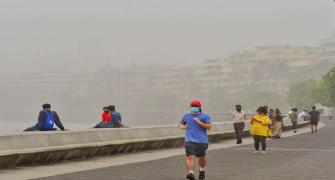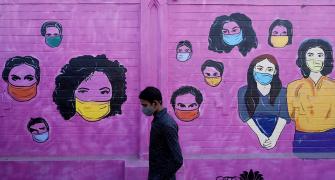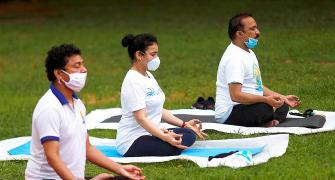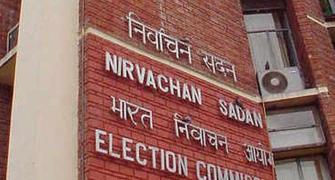'When you are travelling in Mumbai when the air quality is bad, you feel suffocated.'
'You may feel uncomfortable breathing Delhi air, but the level of discomfort is higher in Mumbai.'
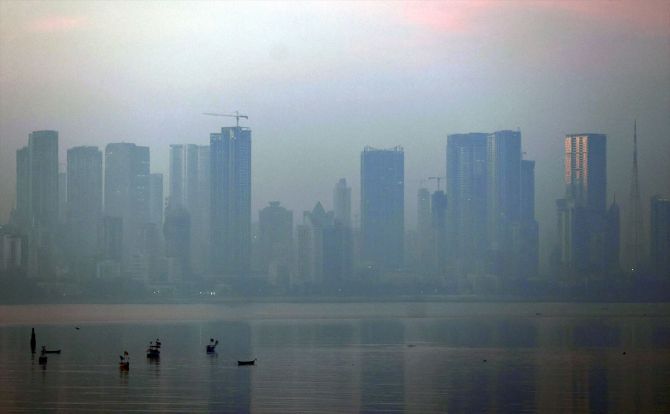
Professor Gufran Beig -- founder, project director, System of Air Quality and Weather Forecasting And Research and Chair Professor National Institute of Advanced Systems -- explains the reasons behind the deteriorating air quality in Mumbai and why Mumbai's air is more toxic than Delhi's in this interview with Prasanna D Zore/Rediff.com.
What are the reasons for Mumbai experiencing sustained poor quality in and how long is this situation likely to continue?
In general, in November and December, Mumbai's air quality normally remains in the moderate category; sometimes it goes to poor, and occasionally it goes to the very poor category.
This is the normal trend for Mumbai's air quality (for November-December).
But in 2022, what has happened during the last 40 days before December 13 is that in the last 30 days during this period the air quality of Mumbai was in the green or 'permissible limit' category for just one day compared to 18 days of green for the same period in 2021.
In 2021, while just six days in past 35 days were in poor category, in 2022, 18 out of the last 35 days were in poor and three were in very poor category.
These data points establish with certainty that something drastically different happened in Mumbai in 2022 than what has been the normal phenomena in years preceding 2022.
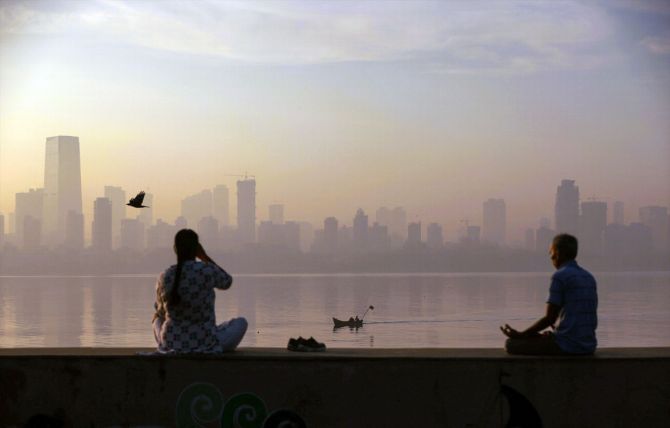
Have you decoded why the air quality pattern has changed so drastically in Mumbai in 2022?
Why it is happening is because we are experiencing (in Mumbai) very prolonged and consistent periods of relatively calm wind speeds all through the last week of November until December 15.
These relatively calmer winds allow the pollutants in the air to remain trapped. If the wind speeds were to be normal, these pollutants get dispersed.
Mumbai being a coastal station, wind speeds are good throughout the year and the pollutants get dispersed.
When the weather and wind speeds are normal, we do not even really feel the (effects of) higher category pollutants dispersed in air due to construction activities like the Metro project or the coastal corridor projects, which release huge amounts of dust and pollutants.
But since the wind speeds have become slow, these pollutants are getting trapped over Mumbai.
Why are we seeing a changed weather pattern in 2022 than what we saw in 2021?
There are two reasons why the weather pattern of Mumbai has changed.
One is prolonged, consistent wind has become totally erratic and it is unusual compared to (what Mumbai has experienced over the) last five years or so.
The second reason is that the frequency of cleaner wind originating from the (Arabian) Sea -- because Mumbai is surrounded by the sea from three sides -- which ships away all the pollutants and replaces them by the cleaner wind, and then again, the pollution built up happens on land and then again winds go towards the ocean side; this wind reversal cycle keeps continuing which keeps Mumbai periodically cleaner even if it (pollution level) goes up occasionally.
But then what has happened is that frequency of this (reversal) cycle has declined, in the sense that it (slow wind speeds were experienced) for almost about 15 days (of December) and only after that the cleaner, stronger winds have come; otherwise (in normal times), the cleaner winds start blowing over Mumbai after the first three days of December.
Now, why are these two changes happening?
The research we did and the weather sensitivity models we built have helped us come out with a very conclusive reason (for these changes).
According to our model interpretation the La Nina phenomena, which is nothing but overheating of the Mediterranean Sea (is responsible for this change in Mumbai's weather pattern).
You may have, until now, heard about the La Nina and El Nino winds affecting the monsoon and rainfall patterns. You may not have heard of La Nina affecting air quality, but that is exactly what our models are proving conclusively and convincingly.

Isn't this then a path-breaking study conclusively and convincingly linking poor air quality over Mumbai with the La Nina effect?
Yes, because it (our research study) is directly connecting you (poor air quality over Mumbai) to climate change (being responsible for worsening quality of air).
Normally, the La Nina effect remains visible for two consecutive years but we have been experiencing La Nina for the third consecutive year and that is likely to continue into the fourth year. Normally, La Nina goes back after two consecutive years.
The La Nina does affect the monsoon and the winter patterns, but this time it has become so strong and so prolonged that continuous heating of surface waters over the oceans is happening for the third year (leading to warmer ocean currents).
Earlier, the La Nina pattern would reverse after two years of heating up of surface waters they would cool and then again the cycle would continue.
But due to continuous heating for a prolonged period winds are getting disturbed during the winter period resulting in rise in temperatures (during the winter months).
Usually, when La Nina is experienced, there is disturbance in wind patterns just before the monsoon, which is the summer period basically. But heating up has gone so much that it started disturbing the wind patterns even in November-December and because of that we are seeing two different climatic conditions above and below the Turf Line in India which passes through the bottom of Rajasthan, central parts of India and finishes somewhere around Bhubaneshwar.
Turf Line is a line which climatologically divides a geographical region into two parts where different climates are experienced.
The Turf Line divides India into two parts: The southern part or peninsular India including the Western parts of India like Mumbai, Pune, and Surat; the region above this Turf Line lie the colder regions, mainly the northern parts of India like Delhi, Punjab, Haryana, Uttar Pradesh, Bihar, etc.
The Turf Line also divides the Westerly disturbances; now, Westerly disturbances are unusually very low. These Westerly disturbances introduce cooling due to presence of moisture in the atmosphere.
So what is happening is that below the Turf Line, that is, over peninsula India and Western parts of India La Nina winds are becoming slower.
And above the Turf Line, winds are becoming relatively faster to make up the energy balance. You cannot have high frequency winds in two different climatological regions.
So you must have seen air quality becoming better in Delhi during this period of time and during the same period of time air quality of Mumbai and southern part of India, peninsular India is becoming worse.
Now, consecutively for the third year the La Nina winds are changing and why this is happening is what scientists have concluded is because of the climate change.
So, prolonged La Nina due to climate change, unusual and prolonged disturbance in wind patterns, and delay in reversal of wind patterns are resulting in trapping of pollutants thereby worsening the air quality during the months (November-December-January) which had experienced cleaner and cooler air in previous years.
Indirectly, these are the change of events and climate patterns that can be indirectly attributed to climate change.
But this particular chain of events is unlikely to remain for more time going ahead because the onset of winter has arrived in Delhi due to some other processes and due to which it is getting warmer in regions that lie below the Turf Line.

How toxic is Mumbai's air quality compared to say Delhi and what factors are leading to an increase in toxicity of air over Mumbai?
When we talk about PM2.5 (Fine Particulate Matter 2.5; more PM2.5 leads to poor visibility) we talk only about the size of pollutants, whether they are smaller of finer or bigger in size; we never talk about the chemical composition of this air.
In general, we found that the chemicals which make PM2.5 are also relatively more toxic in Mumbai as compared to PM2.5 in Delhi or any other region over the Indo-Gangetic plains.
This is because there (over the Indo-Gangetic plains) the chemical composition of PM2.5 is more due to dispersion of minerals and dust -- which are less harmful -- in air.
In Mumbai, since the humidity is always high and the fact that bio-fuel emissions, industrial emissions are higher, and these remain suspended in air for a prolonged period due to presence of water molecules in air (high humidity due to nearness to the sea coast), the toxicity of air in Mumbai is higher due to its chemical composition.
In Mumbai the particulate pollutant in air may be at 125 micrograms per metre cube compared to 150 micrograms per metre cube of Delhi air indicating higher particulate pollutant matter in Delhi air, but because of the nature of chemical composition of air in these two cities, Mumbai air is more toxic than Delhi's.
That is the reason that when you are travelling in Mumbai when the air quality is bad, you feel suffocated; you also get foul smells at some places in Mumbai, whereas you don't feel too suffocated or suffer from headaches in Delhi.
You may feel uncomfortable breathing Delhi air, but the level of discomfort is higher in Mumbai.
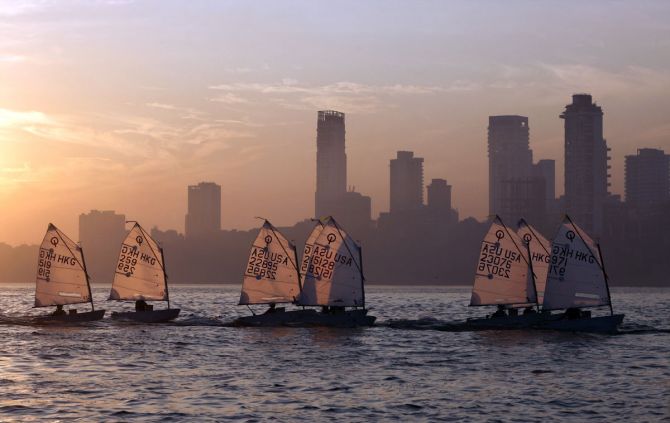
When is the situation likely to improve in Mumbai?
In Mumbai, as far as air quality is concerned, the situation has improved. Now Mumbai's air quality is in moderate category since December 14-15.
Though the wind speeds are still calmer, cleaner air has started blowing from the sea. It could have undergone a reversal again, but then it (calmer, cleaner winds) has been persisting for six days.
While the bad winds persisted for more than 10-15 days in December 2022 (which till last year was three-four days) we need to see whether good winds will also prevail over the next 10-15 days (till December 20, we have had only five-six days of good winds).
The fact that it is about six days since we have been experiencing cleaner air gives a ray of hope.
How much of the polluted air over Mumbai could be attributed to intense construction activity and vehicular traffic in Mumbai?
In Mumbai, 30 per cent (of pollution) comes from the transport sector emissions and around 22 per cent comes from industrial pollutants, 20 per cent from bio-fuel emissions and, in general, only 15 per cent emissions come from the re-suspended dust.
Re-suspended dust can be fatal, in the sense that it consists of small as well as bigger dust particles.
When winds get stagnant, the visibility goes down due to bigger dust particles and air quality also goes down because of small dust particles are their small particle will not deteriorate your visibility, but bigger particular did deteriorate.
There was a theory going around that this pollution (in Mumbai) was only because of the (BPCL) refinery (near Mahul). I humbly beg to differ with that because refineries lead to smaller but toxic dust particles and chemicals and so it deteriorates the air quality but not the visibility.
The fact that this time (when the entire blame for Mumbai's poor to very poor air quality was put on the refinery) both PM2.5 and PM10 (which contains inhalable particles) equally went bad and the fact that the visibility too declined in addition to the air quality, the needle of suspicion should go to those sources which emit bigger as well as small particles, for which the construction activities are responsible.
Coastal road projects as well as Metro rail projects become leading factors of pollution when winds remain stagnant.

